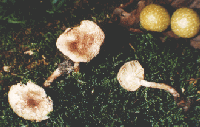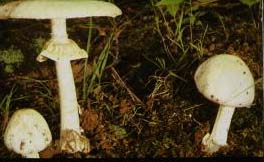Home
Epilogue
A strange twist to Mom's story:
At the beginning of this ordeal, toxicologists wanted to isolate the
mushroom which poisoned Carmen. They could not identify certain mushrooms sampled
from the farm while the others were identified as non-poisonous.
A week after Mom's liver transplant, it took a mushroom expert to
finally identify the mushrooms. They turned out to be poisonous and are the ones
which made her ill.
Tragically, these mushrooms are very rare in the East coast and can
easily be mistaken for not-toxic varities.
A report from Rommel:
"Anything I read about poison
mushrooms refers to the more common type from the Aminita variety (on the right).
The Lepiota variety (that which poisoned Carmen) is far less common in these parts
and therefore there are far fewer reported cases of it. In fact my mushroom book
identifies it's range as "California" and it's growing season as "January
through March". If it grows in the opposite side of the continent then the
growing season will be inverse.
From a clinical perspective, I guess it doesn't
matter what variety of mushroom mom ate because they both contain the deadly Aminita
Toxin. I don't have a scanner so I can't show you what it looks like, but it
looks VERY SIMILAR to a 'Shaggy Mane' which is a very common, harmless mushroom. I
fact, the Lepiota is quite small and I'm surprised mom would pick it. It was so rare that
Mark (and the other mushroom guy) was not able to identify it and it had to send to
Syracuse for testing! "
A Picture of Lepiota josserandii

.
|
Samples of the Aminita mushroom family

These are appropriately called the "Death Cap" (Aminita
Phylloides), as they are the most deadly of the Aminita genus.

These are called "Destroying Angel" (Aminita
Virosa).

These are called "Toadstool" or
"Fairytale" mushrooms (Aminita Muscaria). They are the same variety as the
one that serves as the icon of this web site. Despite the benign nicknames, these
are also highly toxic.
Both are highly toxic but Death Cap is more common than
Destroying Angel. People are more likely drawn to it because of it's size, shape and
color.
After a visit to the Wagner Farm with a mycologist expert and Dr. Donnelly, it was
immediately obvious to them that the farm is NOT the ideal place for these two mushrooms
to grow because of the type of trees growing on the property. It's not say they are not
there, it's just LESS LIKELY that they can grow there.
These mushrooms need a type of tree to share their roots with. The two types of tree they
like are and Pine trees primarily, and Hardwoods secondarily. The Farm has no Pines and
very few hardwoods.
General characteristics of these deadly Amanitas are:
- White to buff to yellowish to reddish and brown caps
- White spores
- White to off-white gills
- An annulus (ring or skirt) on the stem
- A volva (a sac-like bulb) at the base of the stalk.
Note that not all of these characteristics may be present
(due to environmental damage like rain or animals), or easily noticeable
|